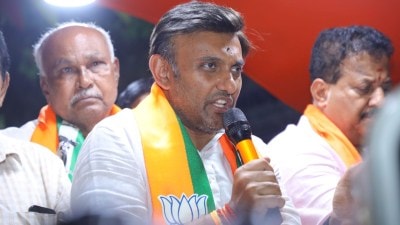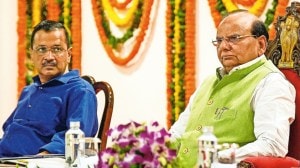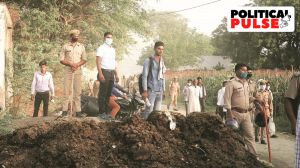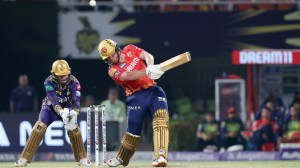- India
- International
‘While privatisation is desired, in-house manufacturing units are also essential’
Having served in the Territorial Army up to the rank of Brigadier prior to joining the Indian Railways, Sunil Kumar Sood is known to be a strict disciplinarian and decision maker.
 (Source: Express photo by Ganesh Shirsekar)
(Source: Express photo by Ganesh Shirsekar)
SHAJI VIKRAMAN: Doesn’t it present a dilemma — you have to maintain services and there is huge requirement of funds — How do you manage?
There is plenty of dilemma and also serious negotiations for funds with the Railway Board. Often the Board does not agree on certain issues with us at all, since they make rules for entire the Indian Railways, including suburban. A station like Kalyan handles 900 trains while other station may get not more than 200 trains per day. But the rules and methodologies will be same for both. However, given the heavy passenger traffic, more funds are needed.
KALPANA VERMA: The Centre wants to privatise manufacturing units of the Indian Railways. What do you think?
While privatisation is desired, in-house manufacturing units are also essential. I think a mix of both is essential. Say I have a sudden need of some coaches. In that case I can easily approach the in- house unit and give them a deadline. However, in case of private companies, I will have to place an order at least two years before the delivery of the product.
SHUBHANGI KHAPRE: In the past 15 years, we have seen cost cutting across boards in administrative and areas of manpower in Western and Central Railways. At the Centre, however, there is always emphasis on massive expansion. How difficult is it to manage this mismatch?
The Parliament has announced construction projects of approximately Rs 1.5 lakh crore. And these sanctioned projects are at least 20-year old projects and nobody has checked the revised cost as on today’s date. But, what they are able to give is only Rs four-five thousand crore per year, which means they will take 60 years even if no new projects are sanctioned. Board has taken
up only 30 per cent of total projects. There is a need for good management.
SHUBHANGI KHAPRE: Is there any mechanism to analyse the projects in pipeline and the ones slotted for future and then modify the languishing projects based on new data?
Earlier there was political pressure but over the past four-five years no political pressure has been there. The Railways tries its best in going for projects with earnings. But if there is political pressure on having a coach factory or any other project, it sails through even if resources are less.
SHAJI VIKARMAN: When the dedicated freight corridor comes up, particularly on the Delhi-Mumbai corridor, what happens to Central Railways and other Railways on that stretch? How do you manage? Have you protested against it?
Not at all. This is development. Like the bullet train, it has to be supported. What will be done is that the rules of pricing the passenger fare will be rewritten. Today, the rule is to make goods traffic pay through its nose, a system, which will not even be available to Indian Railways once the Dedicated Freight Corridor (DFC) is set up. It will be a separate corporation, struggling with its own loans.

SMITA NAIR: Will you go in for a proposal for fare hike this time in budget?
Fare hike is left to the Railway Minister. We have a method of proposing a project but no method of proposing fare hike. However, we are not comfortable with monthly season ticket (MST) being so cheap and trains being so overcrowded. We would have got Rs 600 crore extra if the previous fare hike was allowed the way it was initially announced. We need Rs 700-800 crore alone for retrofitting, Rs 250 crore for system shortage and another Rs 900 crore for coaches. I think the state should come up with a policy with common tickets for all modes of transport.
SHUBHANGI KHAPRE: Railways is one of the finest services, but it’s always on the receiving end. How do you cope with it psychologically?
The four words that can make a happy man sad, and a sad man happy is “This too shall pass”.
PRIYAL DAVE: Recently, the High Court came down heavily on the Railways for not doing enough on providing emergency medical rooms at stations (EMR). What is preventing the railways from providing medical service?
This matter is sub-judice and hence I cannot comment on this issue. We already have an EMR functional at Dadar station. We get around 10 patients everyday, of which eight of them complain of headaches, chest pains and the other two complain of scratches during railway accidents. The count is just one-two per month. But yet, we have decided we will open EMRs in all stations.
KAVITHA IYER: Given that the railway minister is from the city and understands the suburban railway, does that impact our chances of getting the railways wish-list done. Has he suggested something?
Till now, Railway Minister Suresh Prabhu is focusing only on urgency plans – that suburban railways trains should not be delayed. He has not gone into the nitty-gritty yet. We have to tell him all our problems.
SMITA NAIR: Is there a study done on the profile of city commuters when it comes to designing rakes or capacity building?
We already know the commuting patterns of passengers in both rush and non-rush hours. We have been regularly requesting state to give flexi-timing or staggered timing so that rush hour travel is evenly spread out throughout the day. They may even have to introduce a policy under which companies have to compensate employees for their travel and not give them only a small allowance.
PRIYAL DAVE: A deluxe toilet was recently opened at Thane station. So clearly there is a policy on toilets, atleast now. What about other stations?
We have two types of stations. Some stations are such where vertical growth is possible. So recently, we have read in the newspapers, that the Prime Minister has announced that private players will be involved for vertical development of railway stations. We have made a policy, which has been submitted to the railway minister recently. For those stations where vertical growth is not possible, we may involve any of the 500 companies on first-come-first- serve basis. We are also trying to approach religious bodies, if they have enough money and reputation.
SHALINI NAIR: Does the Railways have any comprehensive plan for utilising Railway land and capitalising on it?
We tried to lease out our land, but never succeeded. We have made multi-function complexes in South India. They are ready but not sold yet. CIDCO also has made such buildings, but they have not been sold for the last 20 years. When you make a railway station anywhere, everything around the station develops, which leaves very less space around the station for things like parking. One cannot go for any vertical development, unless there is parking space. We also feel that the ground floor should be used for business, the next two floors for parking and then office space. But we prefer parking on the road. I think that if we build a hotel on Railway land, it will never be occupied.
SMITA NAIR: Is Harbour Line ever going to have fast trains?
Two months ago, a very big project was sanctioned on creating the fifth and sixth line from CST to Kalyan. But this project cannot take off unless the Harbour line is shifted. So, we have proposed that Harbour line from Dockyard Road station towards Town Side should run along the boundary of the Port Trust land. This line will end on the other side of the P D’mello Road. The new Harbour line will go from Dockyard to Panvel, not via Sandhurst , through the other side of Eastern Freeway. So Harbour Line passengers instead of getting on trains on CST platform number 1 and 2, will catch the train from an elevated deck on other side of P D’mello Road, which will be connected to the longest FOB at CST station. We have also suggested skywalks up to Ballard Pier. If this new Harbour Line comes, the fifth and sixth CSTM-Kalyan lines can be built. Or else, it will terminate at Parel. We could even have metro type rakes on the new Harbour line as it is diverse and separated from the existing train tracks. Rani Jadhav committee for Port Trust land use has included this new Harbour line concept in its plan. We have drafted the letter and given it to the CM.
SANDEEP ASHAR: Western Railway has been pushing for PPP model. What is the Central Railway’s strategy? Does it prefer cash contracts or PPP models for upgradation of infrastructure?
Station upgradation is done through revenue budget. However, if we want a separate Panvel to CSTM line, or one from here to Ahmedabad, we could do it through PPP, provided you can show some earning to those investing in the project. We need to take a decision on what model to follow. How will a person investing in the project get his profit? What will be the model of fares and how loans will be paid back is unknown. Projects like Dedicated Freight Corridors (DFC), which are being carried out under partnerships can have an impact on daily operations. For example, if the DFC comes, we will loose all our freight traffic. This will have consequences on passenger fares as presently freight subsidizes passenger fares. So, a lot of planning is required for major projects and the models under which they are to be built.
Transcribed by Tabassum Barnagarwala, Anjali Lukose, Gautam S Mengle & Meghna Yeluru
Apr 27: Latest News
- 01
- 02
- 03
- 04
- 05































